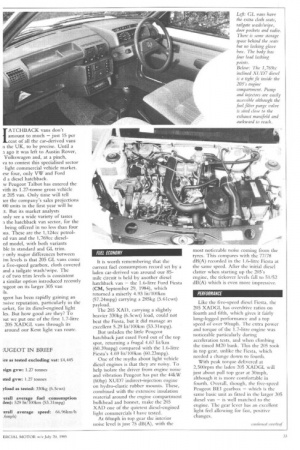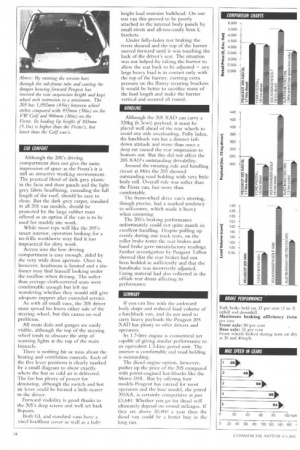PERKY LITTLE
Page 34

Page 35

Page 36

If you've noticed an error in this article please click here to report it so we can fix it.
PEUGEOT
If you can live with the bodyshapc and payload limitations of hatchback-derived vans, the commercial version of Peugeot's 205 has much to commend it.
IATCHBACK vans don't amount to much — just 15 per cent of all the car-derived vans a the UK, to be precise. Until a a ago it was left to Austin Rover, Volkswagen and, at a pinch, va to contest this specialised sector light commercial vehicle market. ese four, only VW and Ford
d a diesel hatchback.
w Peugeot Talbot has entered the vith its 1.27-tonne gross vehicle it 205 van. Only time will tell ter the company's sales projections 100 units in the first year will be :t. But its market analysts
,usly see a wide variety of tastes a the hatchback van sector, for the being offered in no less than four ins. These are the 1,124cc petroled van and the 1,769cc dieseled model, with both variants ble in standard and GL trim. t.. only major differences between im levels is that 205 GL vans come a five-speed gearbox, cloth covered and a tailgate wash/wipe. The
e of two trim levels is consistent a similar option introduced recently mgeot on its larger 305 van 1s.
igeot has been rapidly gaining an ssive reputation, particularly in the larket, for its diesel-engined light ]es. But how good are they? To mt we put one of the first 1.7-litre 205 XADGL vans through its around our Kent light van route. FUEL ECONOMY
It is worth remembering that the current fuel consumption record set by a laden car-derived van around our 85mile circuit is held by another diesel hatchback van — the 1.6-litre Ford Fiesta (CM, September 29, 1984), which returned a miserly 4.93 lit/100kin (57.24mpg) carrying a 285kg (5.61cwt) payload_
The 205 XAD, carrying a slightly heavier 330kg (6.5cwt) load, could not beat the Fiesta, but it did manage an excellent 5.29 lit/100km (53.31mpg).
But unladen the little Peugeot hatchback just eased Ford out of the top spot, returning a frugal 4.67 lit/km (60.39mpg) compared with the 1.6-litre Fiesta's 4.69 lit/100km (60.23mpg).
One of the myths about light vehicle diesel engines is that they are noisy. To help isolate the driver from engine noise and vibration Peugeot has put the 44kW (60hp) XUD7 indirect-injection engine on hydro-elastic rubber mounts. These, combined with the extensive insulation material around the engine compartment bulkhead and bonnet, make the 205 XAD one of the quietest diesel-engined light commercials I have tested.
At 60mph in top gear the interior noise level is just 75 dB(A), with the
most noticeable noise coming from the tyres. This compares with the 77/78 dB(A) recorded in the L6-litre Fiesta at the same speed. After the initial diesel clatter when starting up the 205's engine, the tickover levels fall to 51/52 dB(A) which is even more impressive.
PERFORMANCE
Like the five-speed diesel Fiesta, the 205 XADGL has overdrive ratios on fourth and fifth, which gives it fairly long-legged performance and a top speed of over 90mph. The extra power and torque of the 1.7-litre engine was noticeable particularly during acceleration tests, and when climbing the timed M20 bank. This the 205 took in top gear, unlike the Fiesta, which needed a change down to fourth.
With peak torque delivered at 2,500rpm the laden 205 XADGL will just about pull top gear at 30mph, although it is more comfortable in fourth. Overall, though, the five-speed Peugeot BE1 gearbox — which is the same basic unit as fitted in the larger 305 diesel van — is well matched to the engine. The gear lever has an excellent light feel allowing for fast, positive changes.
CAB COMFORT Although the 205's driving compartment does not give the same impression of space as the Fiesta's it is still an attractive working environment. The practical blend of dark grey plastic in the facia and door panels and the light grey fabric headlining, extending the full length of the roof, should be easy to clean. But the dark grey carpet, standard in all 205 van models, should be protected by the large rubber mats offered as an option if the van is to be used for muddy site work.
While most reps will like the 205's smart interior, operators looking for a no-frills workhorse may find it too impractical for dirty work.
Access into the low driving compartment is easy enough, aided by the very wide door aperture. Once in, however, headroom is limited and a sixfooter may find himself looking under the roofline when driving. The softer than average cloth-covered scats were comfortable enough but left me wondering whether they would still give adequate support after extended service.
As with all small vans, the 205 driver must spread his knees either side of the steering wheel, but this causes no real problems.
All main dials and gauges are easily visible, although the top of the steering wheel tends to obscure the strip of warning lights at the top of the main binnacle.
There is nothing hit or miss about the heating and ventilation controls. Each of the five lever positions is clearly marked by a small diagram to show exactly where the hot or cold air is delivered. The fan has plenty of power for demisting, although the switch and hot air lever could be located a little nearer to the driver.
Forward visibility is good thanks to the 205's deep screen and well set back B-posts.
Both GL. and standard vans have a vinyl loadfloor cover as well as a half heightload restraint bulkhead. On our test van this proved to be poorly attached to the internal body panels by small rivets and all-too-easily bent L brackets.
Under fully-laden test braking the rivets sheared and the top of the barrier moved forward until it was touching the back of the driver's scat. The situation was not helped by raking the barrier to allow the seat back to be adjusted — any large heavy load is in contact only with the top of the barrier, exerting extra pressure on the flimsy securing brackets. It would be better to sacrifice some of the load length and make the barrier vertical and secured all round.
HANDLING Although the 205 XAD can carry a 320kg (6.3cwt) payload, it must be placed well ahead of the rear wheels to avoid any axle overloading. Fully laden, the hatchback van has a distinct taildown attitude and more than once a deep rut caused the rear suspension to bottom out. But this did not affect the 205 XAD's outstanding drivability.
Around the twisting ride and handling circuit at Mira the 205 showed outstanding road holding with very little body roll. Overall ride was softer than the Fiesta van, but more than comfortable.
"1-he front-wheel drive van's steering, though precise, had a marked tendency to self-centre, which made it heavy when cornering.
The 205's braking performance unfortunately could not quite match its excellent handling. Despite pulling up evenly during our track tests, on the roller brake tester the rear brakes -and hand brake gave unsatisfactory readings. Further investigation by Peugeot Talbot showed that the rear brakes had not been bedded in sufficiently and that the handbrake was incorrectly adjusted. Lining material had also collected in the offside rear drum affecting its performance.
SUMMARY If you can live with the awkward body shape and reduced load volume of a hatchback van, and do not need to carry heavy payloads the Peugeot 205 XAD has plenty to offer drivers and operators.
Its 1.7-litre engine is economical yet capable of giving similar performance to an equivalent 1.3-litre petrol unit. The interior is comfortable and road holding is outstanding.
The diesel engine option, however, pushes up the price of the 205 compared with petrol-engined hatchbacks like the Metro 310L. But by offering four models Peugeot has catered for most operators and the base model, the petrol 205XA, is certainly competitive at just 0,640. Whether you go for diesel will ultimately depend on annual mileages. If they are above 30,000 a year then the diesel van could he a better buy in the long run.




















































































